Mold Testing with Petri Dishes- Collection Process Explained
 If you have a chronic health issue, the truth is, you cannot take mold exposure lightly. Anything that aggravates the immune response can trigger systemic inflammation, especially something you inhale repeatedly. If anyone knows how serious this topic is, it’s me. My daughter was literally disabled from exposure to mycotoxins until we discovered that mold was triggering it.
If you have a chronic health issue, the truth is, you cannot take mold exposure lightly. Anything that aggravates the immune response can trigger systemic inflammation, especially something you inhale repeatedly. If anyone knows how serious this topic is, it’s me. My daughter was literally disabled from exposure to mycotoxins until we discovered that mold was triggering it.
How I Developed the Petri Dish Collection Process
After years of watching my daughter suffer, I was finally willing to test the mold theory. The problem was that there were several different types of mold tests out there, and I didn’t know which one to rely on. I figured, why not start with the least expensive one and juice up the process for better results? This would show me if there was potentially a mold issue without breaking the bank.
I did several of these petri dish tests and started to see some interesting correlations. My daughter was sickest in the houses/rooms that had high levels of blue or black mold. I then chose to try these tests with my clients, and sure enough, the people who had the most dense samples were often the ones with the most extreme immune reactions.
Refer below for instructions on how to take the sample correctly. It is important to avoid the instructions on the box and just follow the steps below:
Mold Testing with Petri Dish- Optimized Air Collection Process
(1) Do not clean or dust for 3 to 4 weeks prior to testing
(2) Purchase Mold Testing kits and set aside time to perform tests. If you do not have a box fan, purchase that as well.
(3) Open the Petri dish and pour the culturing liquid into it. Immediately place it on the ground to start culturing process.
(4) Place petri dish in various locations throughout your testing room. Very important – keep the fan several feet off to the right, deflecting air off the wall towards the petri dish. Keep the petri dish on the outside edges of the room when moving it around several times. Keep it in each location for 45 minutes or so, for a total of 6 hours. Sweep the outside edge and corners of the room with a broom to collect dust. Then sweep towards the petri dish a few times.
(5) Move the petri dish to the middle of the room, let it collect for an hour, then place it somewhere elevated to collect for another hour.
(6) Congratulations, you’re almost done! Put the top on the petri dish and store it in a dark place. Check on it in five days or so.
(7) Compare your pictures to the ones below. Pay special attention to the notes to learn how to determine if there is an issue or not. Keep in mind that there is usually an option to send the test to a lab as well. The only downsides are that it costs money, and they usually tell you the mold species, not the strain.
Reading your Petri Dish Results
If you see mold growing on your petri dish, don’t panic! Every single house will have mold. If nothing grows on your petri dish, it’s because you did something wrong during the collection process. Take a look at some pictures below to help understand what is safe and what isn’t.

Though it doesn’t look pretty, it’s nothing to be concerned about. There is very little density, no black, minimal blue, etc., and mostly yellow spores. I would be concerned if I saw more of those orange spores (aspergillus), but there are very few.
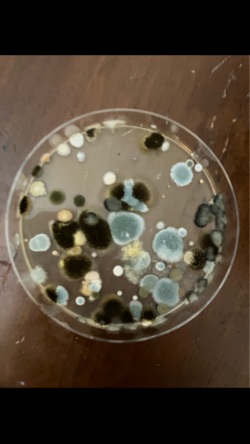
The blue is penicillium mold, which can be a problem for your health, but nowhere near the black stuff you see there. That is stachbotrys, which causes various health issues. This was the petri dish from my daughter’s room at the house that she was very sick in. I also felt lower in energy than normal in that house, but didn’t make the correlation until after we left.
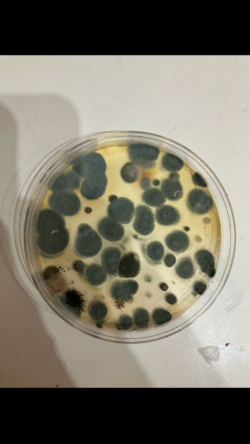
This is from the bathroom in the house my daughter had tons of issues at. I swear my ears would ring for 20 minutes after taking a long shower in there. Was it from the mold? Who knows at this point. As you can see, the density is high and it contains plenty of blue mold (penicillium mold). It also has a couple sketchy looking dark spots on there that could be black mold.
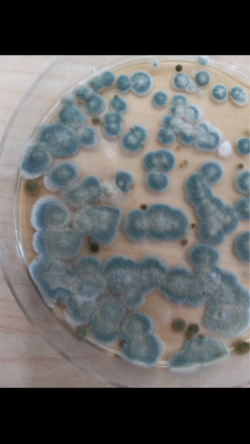
This is from someone with various food sensitivities, gut issues, and other immune dysfunctions. It turned out that not only was there mold in the place, but it was also within the walls. As you can see, the density is high, and the color blue (penecillium mold) is always a red flag.
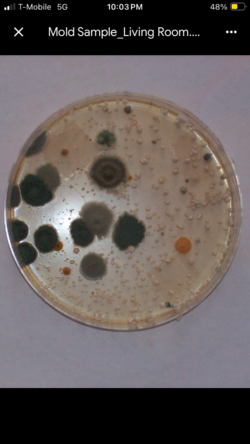
There is definitely some penicillium mold, but my main concern is how many of those little spores that are on there. No matter what, that is an extremely high density. This person had a number of environmental sensitivities and maybe this particular mold had something to do with it.
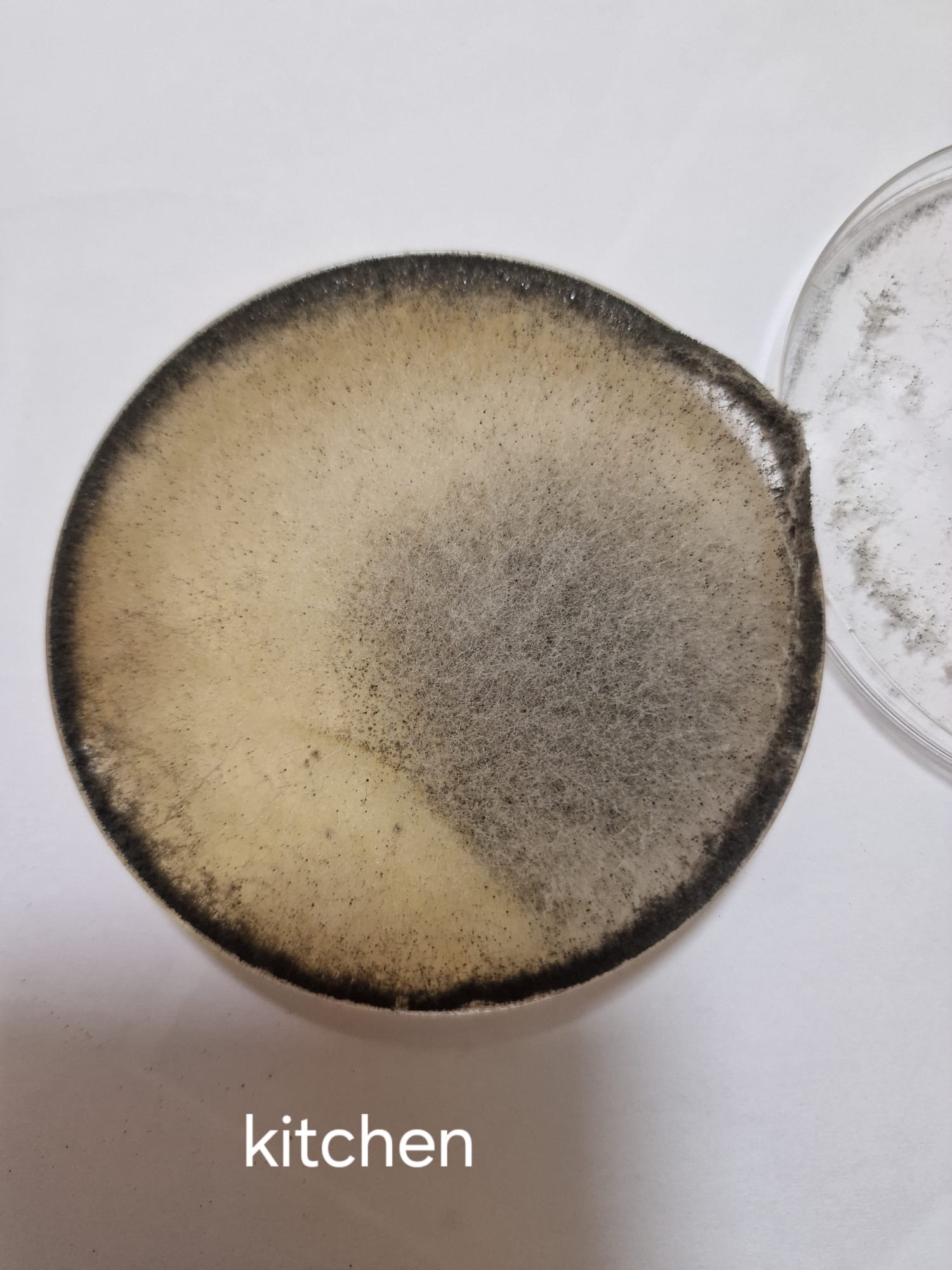
This is black mold. You can see the black with the little white spots or hairs. That is a major problem. You can see it was prevalent in this person’s kitchen. Coincidentally, this person had an autistic child. Was this mold the cause of many of her symptoms? It is very possible.
Frequently Asked Questions – Mold Petri Dish Test
Why do you prefer this modified petri dish test process?
It is in an inexpensive and effective way to see if there is a mold issue. Also, you can get the results within the week and if it looks concerning, you can send it out to the lab to identify the species. In my experience, I have found it to be more accurate than the typical box air collection tests.
What have your experiences been with the petri dish process?
The petri dish test proved to be priceless to me. It helped me identify that there was toxic mold in the places I was living. With this info, I was finally able to make the correlation that the places I lived where the tests came back the worst were also where my daughter was the sickest.
If I have a whole house, how should I perform the test?
If you own a house, you can do a test in each room to figure out where the mold is the worst. You can find websites that sell 10 mold testing kits for $60 or so. The only downside to this is the time it takes to complete the process. I have seen many clients perform tests in their homes, and they are rarely a waste of time or money.
Which room of the house should I test first?
The most important room to test is the bedroom. The reason is, you spend more time in this room than any other. If someone is waking up with certain symptoms, then I would even consider doing 2 petri dish tests at the same time to verify results.
Is it really important to use box fans when doing the petri dish test?
Yes, mold spores are typically not just flying around in the air all day. You have to use something to provoke them into the air so that they can land on the petri dish and culture. This is where the box fan strategy comes in. It MUST also be pointed several feet to the side of the dish, to deflect air off the wall and towards the petri dish. You NEVER want have it pointed directly at the petri dish or the spores will never land on it.
How long should I let the petri dish sit out?
Ideally, you want the petri dish to sit out for around eight hours. The goal is to move it around in several different locations throughout the room. The best places to move it are around the edges of the room, under dressers/couches/beds, in the places where dust collects, and then somewhere in the middle of the room. I would keep it in each location for roughly 45 minutes. Once it has been out for eight hours, put the top on and store it in a dark place to culture.
Is there a specific brand of mold testing kit you use?
I used the Mold Armor do-it-yourself testing kit, but I have also had clients successfully use other brands. You can use either potato starch or agar as the culturing medium. Please note: Do not follow the instructions on the box; follow the instructions in this post to get the most accurate results.
If I get positive results, what do I do next?
The answer depends on your results and how sick you are. In some cases, you have to eliminate exposure, change your diet, support your gut, and get on binders to completely recover. In other cases, you make can improve with far less effort. It all depends on your history and current state of health. If you would like to discuss this further, please get in touch with me. I have plenty of experience with mold illness and recovery.
Petri Dish Test is a Useful Tool if Done Properly
Despite what many “mold experts” may claim, there is great potential behind the petri dish test. In my opinion, the key is to use the proper test collection process. if you use the test process on the box, you are less likely to get accurate results. If you use the collection process written above, the test can provide tremendous value for next to nothing. Remember, if you don’t provoke the spores with the box fan, and sweep your dust toward the petri dish, you will never know what lurks in the shadows. Don’t skip these critical steps, or you will pay in accuracy.
If you think that mycotoxins may be affecting your health, get in touch. I have dealt with this for several years with my daughter and have helped plenty of clients.
Happy healing everyone!
Matt Nedin, B.S.
Certified Holistic Nutritionist
EndSickness, Founder
Phone: (734) 846-8619
WhatsApp: +17348468619
Email: endsickness@gmail.com








